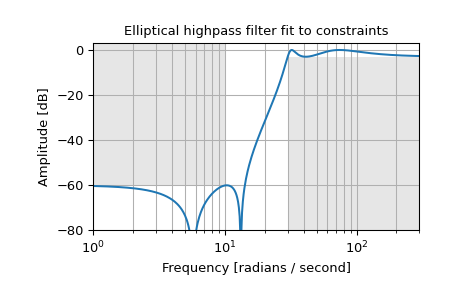ellipord#
- scipy.signal.ellipord(wp, ws, gpass, gstop, analog=False, fs=None)[source]#
Elliptic (Cauer) filter order selection.
Return the order of the lowest order digital or analog elliptic filter that loses no more than gpass dB in the passband and has at least gstop dB attenuation in the stopband.
- Parameters:
- wp, wsfloat
Passband and stopband edge frequencies.
For digital filters, these are in the same units as fs. By default, fs is 2 half-cycles/sample, so these are normalized from 0 to 1, where 1 is the Nyquist frequency. (wp and ws are thus in half-cycles / sample.) For example:
Lowpass: wp = 0.2, ws = 0.3
Highpass: wp = 0.3, ws = 0.2
Bandpass: wp = [0.2, 0.5], ws = [0.1, 0.6]
Bandstop: wp = [0.1, 0.6], ws = [0.2, 0.5]
For analog filters, wp and ws are angular frequencies (e.g., rad/s).
- gpassfloat
The maximum loss in the passband (dB).
- gstopfloat
The minimum attenuation in the stopband (dB).
- analogbool, optional
When True, return an analog filter, otherwise a digital filter is returned.
- fsfloat, optional
The sampling frequency of the digital system.
Added in version 1.2.0.
- Returns:
See also
Notes
Array API Standard Support
ellipordhas experimental support for Python Array API Standard compatible backends in addition to NumPy. Please consider testing these features by setting an environment variableSCIPY_ARRAY_API=1and providing CuPy, PyTorch, JAX, or Dask arrays as array arguments. The following combinations of backend and device (or other capability) are supported.Library
CPU
GPU
NumPy
✅
n/a
CuPy
n/a
✅
PyTorch
✅
⛔
JAX
⚠️ no JIT
⛔
Dask
⚠️ computes graph
n/a
See Support for the array API standard for more information.
Examples
Design an analog highpass filter such that the passband is within 3 dB above 30 rad/s, while rejecting -60 dB at 10 rad/s. Plot its frequency response, showing the passband and stopband constraints in gray.
>>> from scipy import signal >>> import matplotlib.pyplot as plt >>> import numpy as np
>>> N, Wn = signal.ellipord(30, 10, 3, 60, True) >>> b, a = signal.ellip(N, 3, 60, Wn, 'high', True) >>> w, h = signal.freqs(b, a, np.logspace(0, 3, 500)) >>> plt.semilogx(w, 20 * np.log10(abs(h))) >>> plt.title('Elliptical highpass filter fit to constraints') >>> plt.xlabel('Frequency [rad/s]') >>> plt.ylabel('Amplitude [dB]') >>> plt.grid(which='both', axis='both') >>> plt.fill([.1, 10, 10, .1], [1e4, 1e4, -60, -60], '0.9', lw=0) # stop >>> plt.fill([30, 30, 1e9, 1e9], [-99, -3, -3, -99], '0.9', lw=0) # pass >>> plt.axis([1, 300, -80, 3]) >>> plt.show()
